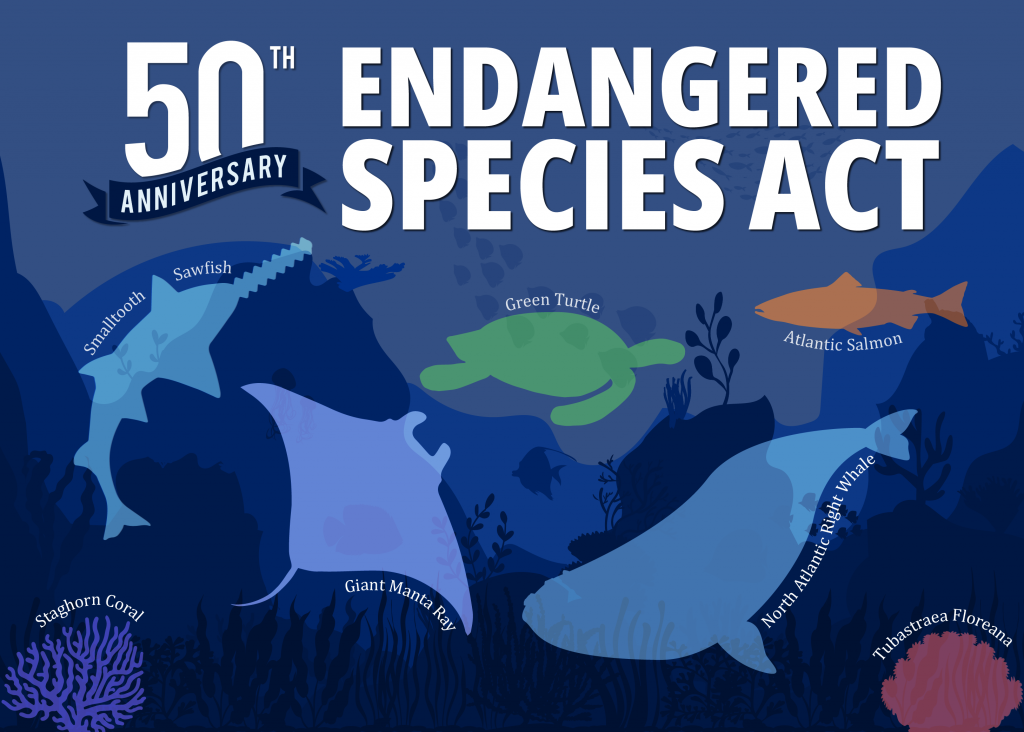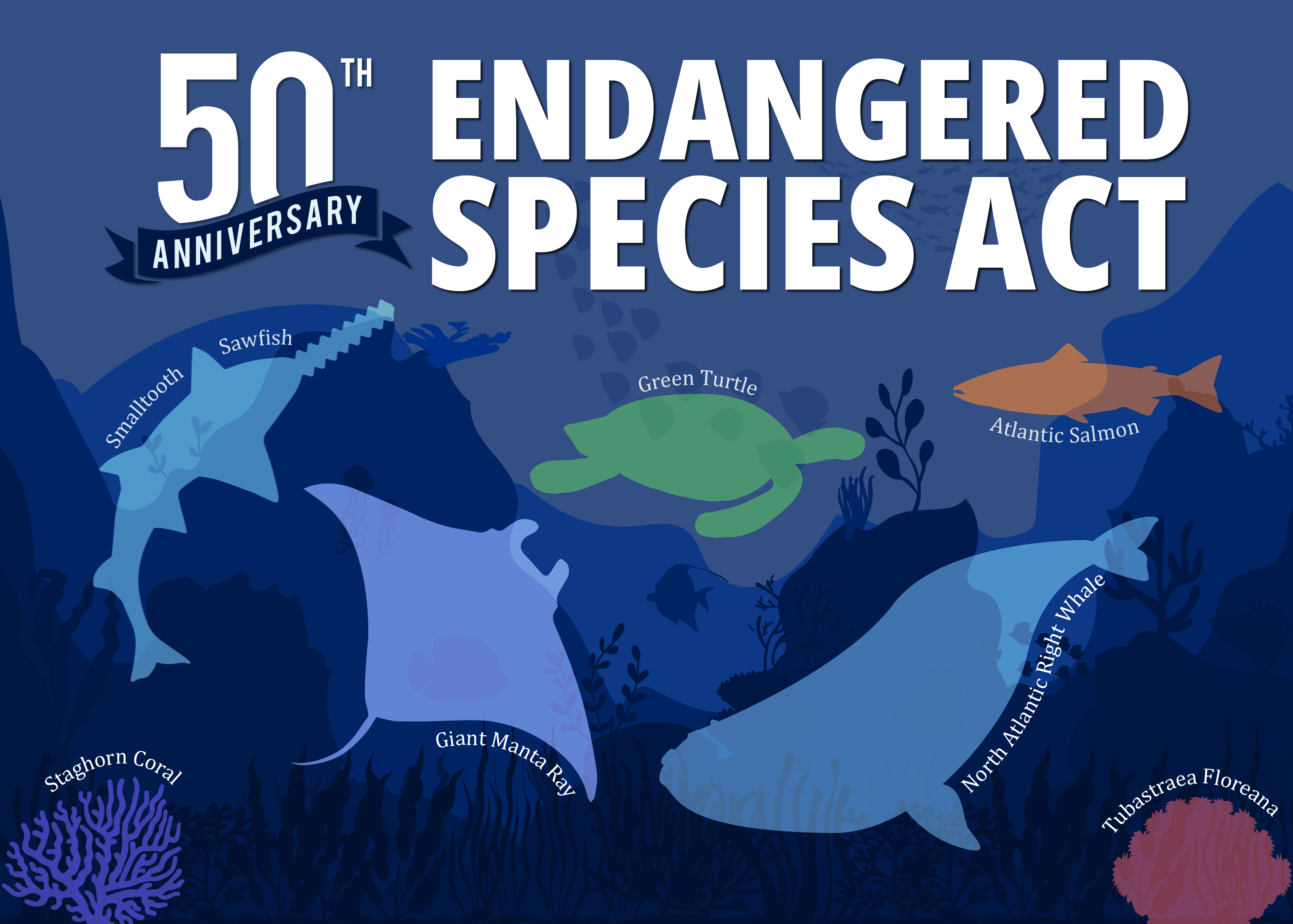2023 marked the 50th anniversary of the Endangered Species Act, one of the earliest, strongest, and most important conservation laws on Earth. The environmental non-profit Defenders of Wildlife wrote a report tracking successes (so far) and proposing improvements for the future. I interviewed Dr. Lindsay Rosa, the Vice President of Conservation Research and Innovation at Defenders of Wildlife, about the report she coauthored. A lightly edited transcript of our interview follows.

Graphic courtesy NOAA Fisheries
What’s special or unique about the Endangered Species Act, and how does it compare to other countries’ environmental laws?
“The Endangered Species Act is considered the most comprehensive legislation for the preservation of endangered species ever enacted and its creation established an important precedent for other countries to follow in terms of domestic species protection programs. Some characteristics that are unique to the ESA and contribute to its success include the fact that whether or not a species is listed and protected is based on science, not politics.
Protections that prevent harming a species or their habitat apply to all species everywhere in the United States, not just on Federal lands like Canada’s Species At Risk Act. Species don’t pay much attention to the political boundaries that we’ve imposed on the landscape so, they aren’t sticking to just a National Wildlife Refuge, they may be crossing over onto Forest Service lands, military lands, etc. If the actions of one agency are undermining the conservation work that others are implementing, then it is hard to achieve recovery.
Citizens have power to engage in endangered species conservation, including petitioning the government to list a species, commenting on proposed rules, and suing the government for not following the rules. There’s also a focus on recovery, not only preventing extinction- it calls for proactive action to recover species to the point where they no longer need ESA protections, using the whole Federal government to achieve this end.”
What are some success stories from the Endangered Species Act?
“The Endangered Species Act is already responsible for over 50 full recoveries, the ultimate success! Of course, there are hundreds of other successes as well because without the protections of the Act, those species would likely already be extinct. Some of my favorite recovery stories include the American Alligator and the Magazine Mountain Shagreen.
There are few things more iconic to the southeastern U.S. than alligators. They are a keystone species in amazing, lush ecosystems like the flooded grasslands of the Everglades. And they are a species that has not changed since the time of the dinosaurs! Think about all of the challenges that the alligator has seen in 150 million years and then think about it only taking a few decades of uncontrolled hunting by humans and destruction of their habitat to bring them to near extinction by the 1950s. This seems so emblematic of the crisis we face today, we are losing species and biodiversity at a rate unprecedented in human history and driven by human activities. It also means that there is hope. We can still act to get these species the protections necessary to bring them back from the brink of extinction. This species was afforded the protections of the Act before it was too late and in 1987, the American Alligator was taken off of the endangered species list due to recovery.
There is only one invertebrate that has been removed from the ESA’s list due to recovery: the Magazine Mountain shagreen. This land snail is found nowhere else on earth than on this mountain in Arkansas. The major threats to the species in the 1980s were proposed military training on the mountain, construction of the state park lodge and land use management practices by the U.S. Forest Service. Recovering the species required state and federal agencies to do everything that was in their power to conserve the species. And they did! The army withdrew its plan for training, the lodge was constructed in a location outside of important habitat, and the Forest Service implemented special management practices to protect the snail’s habitat.”
Your report focuses on political interference as a threat to the Endangered Species Act. Why do some people oppose the ESA, and why are they wrong?
“The ESA was enacted in 1973 with nearly consensus vote in both the House and Senate and today it continues to have the support of the American people. Polls show that nearly 80% of Americans support it. However, we’re currently seeing unprecedented efforts from politicans to weaken the Act and its protections. Their arguments seem to be based on misinformation or misunderstanding.
Some claim that the ESA doesn’t work, or is outdated. As I mentioned earlier, the measure of success goes beyond: over 95% of the species that have been listed under the ESA and benefited from its protections are still with us today. That is an amazing feat, when your purpose is to prevent extinction. It also takes time and resources to move species from the brink of extinction to full recovery and unfortunately, the ESA has been severely underfunded since the very beginning. This leaves some species who are awaiting listing or updated recovery plans without some of those key protections and moving away from recovery. Of course, those who oppose the ESA also like to point to the species that have been removed from the list because they have been determined extinct. If you do a bit of research on these species, you’ll find that most had not been observed in the wild for years, and may have already been extinct, or at least too far gone, for the ESA to help them.
Some claim that the ESA halts economic progress, arguing that proving that any activities that could potentially harm an endangered species will not harm that species or its habitat is an ‘”‘undue burden.’ However, research conducted by Defenders of Wildlife found that in more than 88,000 consultantions, ‘no project was stopped or extensively altered,’ and the ESA has detailed provisions that can allow a wide variety of economic activities to go forward as long as industry takes care to minimize their impacts. Others claim it is government overreach that restricts private property rights, often driven more by a desire to appeal to certain small constituencies than actual concerns or evidence.”
Your report mentions the need to improve the science and technology used in ESA decisionmaking, can you say more about that?
“With new and advancing technologies, there are many doors we have yet to open in our exploration of improving ESA decisionmaking and implementation. Some of those are already being used in conservation, but have yet to be adopted due to resource constraints. However, use of approaches like eDNA, remote sensing and machine learning can ultimately save agencies human-hours in the long run and with pretty impressive results. For example, with eDNA scientists can detect the presence of elusive, endangered species by collecting a sample of water, air or soil. As another example, our skillful data scientists at Defenders’ Center for Conservation Innovation can train computers to look at massive amounts of satellite imagery and detect places where important habitat has been lost or degraded. Importantly, these technologies can also help decisions be more proactive rather than reactive. Instead of looking at where habitat has been lost, we can use that information to predict where losses may be in the future. This is powerful information for thinking about where to strategically site protections.”
Your report says that we don’t necessarily need to change the law, but change how government agencies implement the law, can you say more about that?
“As written, the ESA is a powerful blueprint for saving and recovering species. Unfortunately, the agencies have not always followed its best-available-science mandate and used their authorities to conserve the species and habitats that need protecting.
And of course, one of the largest barriers to implementation is funding. The ESA has long been starved for necessary resources. A Center for Conservation Innovation analysis found that U.S. Fish and Wildlife Service receives only about 40% of what it needs to properly implement the law. This means, among other things, delays in listing species and planning and implementing recovery actions. Now this is more on Congress than the agencies, but we do think the agencies do not always ask for the amount of money they really need.”
What else would you like to say about the Endangered Species Act or your report?
“Not only are we losing species and habitats faster than we have ever before in human history, but our strongest law for fighting extinction is up on the chopping block. Anti-wildlife politicians are weakening the law and its protections, but that is the exact opposite of what we need right now. The consequences are severe! As goes nature, so goes our health, wellbeing, livelihoods and more. And we are already seeing that unfold. Strengthening the Endangered Species Act is one of the most important things we can all do. It needs to be fully funded, it needs strong supporters in Congress and the White House, and it needs everyone to engage in conservation.”

